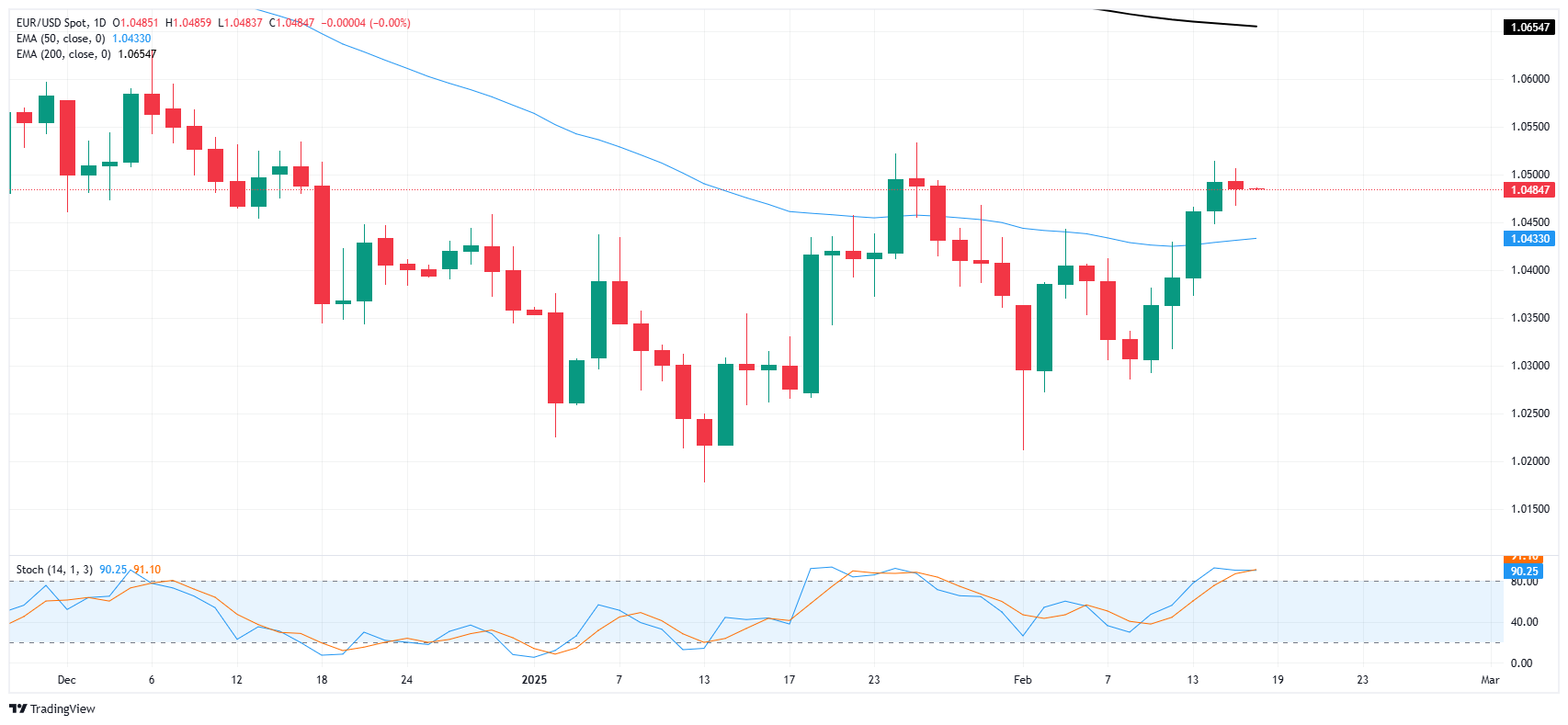EUR/USD flattens on holiday-thinned Monday
- EUR/USD churned close to flat near the 1.0500 handle.
- European data remains mostly tepid this week, Fed minutes loom ahead.
- US PMI activity results are also due this week, but not until Friday.
EUR/USD swamped out at the 1.0500 handle on Monday, snapping a four-day win streak as Fiber bulls re-think their position. Money markets were constrained by a notable lack of order flow during the US market session, with most major US exchanges dark for the President’s Day holiday. FX markets will return to the fold in force on Tuesday, but Euro bidders may not find much momentum with a thin data docket.
European economic sentiment survey results for both Germany and the wider European region are due early Tuesday, but consumers tend to be reactionary and behind the curve on economic factors, so market impact will likely remain limited. Regardless, the February’s figures are expected to improve from January’s print.
The key US data print this week will be the upcoming Meeting Minutes from the Federal Reserve’s (Fed) latest rate call, due on Wednesday. US Purchasing Managers Index (PMI) survey results are also due this week, but not until Friday.
EUR/USD price forecast
EUR/USD failed to climb over 1.0500 again on Monday, churning just beneath the key technical level as bidders risk running out of gas. Technical oscillators including the Stochastic indicator are flashing warning signs of an overbought technical stance, though confirmation of a turnaround into the low side have yet to materialize.
The pair is trading just north of the 50-day Exponential Moving Average (EMA) at 1.0432, and a firm technical floor appears to be priced in near 1.0300.
EUR/USD daily chart
Euro FAQs
The Euro is the currency for the 19 European Union countries that belong to the Eurozone. It is the second most heavily traded currency in the world behind the US Dollar. In 2022, it accounted for 31% of all foreign exchange transactions, with an average daily turnover of over $2.2 trillion a day. EUR/USD is the most heavily traded currency pair in the world, accounting for an estimated 30% off all transactions, followed by EUR/JPY (4%), EUR/GBP (3%) and EUR/AUD (2%).
The European Central Bank (ECB) in Frankfurt, Germany, is the reserve bank for the Eurozone. The ECB sets interest rates and manages monetary policy. The ECB’s primary mandate is to maintain price stability, which means either controlling inflation or stimulating growth. Its primary tool is the raising or lowering of interest rates. Relatively high interest rates – or the expectation of higher rates – will usually benefit the Euro and vice versa. The ECB Governing Council makes monetary policy decisions at meetings held eight times a year. Decisions are made by heads of the Eurozone national banks and six permanent members, including the President of the ECB, Christine Lagarde.
Eurozone inflation data, measured by the Harmonized Index of Consumer Prices (HICP), is an important econometric for the Euro. If inflation rises more than expected, especially if above the ECB’s 2% target, it obliges the ECB to raise interest rates to bring it back under control. Relatively high interest rates compared to its counterparts will usually benefit the Euro, as it makes the region more attractive as a place for global investors to park their money.
Data releases gauge the health of the economy and can impact on the Euro. Indicators such as GDP, Manufacturing and Services PMIs, employment, and consumer sentiment surveys can all influence the direction of the single currency. A strong economy is good for the Euro. Not only does it attract more foreign investment but it may encourage the ECB to put up interest rates, which will directly strengthen the Euro. Otherwise, if economic data is weak, the Euro is likely to fall. Economic data for the four largest economies in the euro area (Germany, France, Italy and Spain) are especially significant, as they account for 75% of the Eurozone’s economy.
Another significant data release for the Euro is the Trade Balance. This indicator measures the difference between what a country earns from its exports and what it spends on imports over a given period. If a country produces highly sought after exports then its currency will gain in value purely from the extra demand created from foreign buyers seeking to purchase these goods. Therefore, a positive net Trade Balance strengthens a currency and vice versa for a negative balance.

